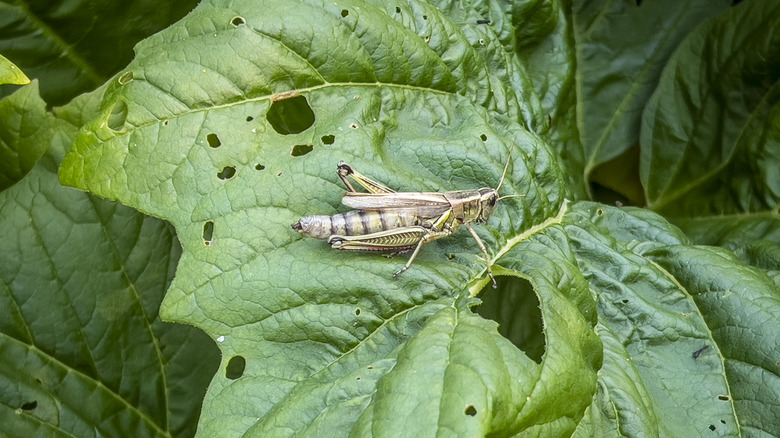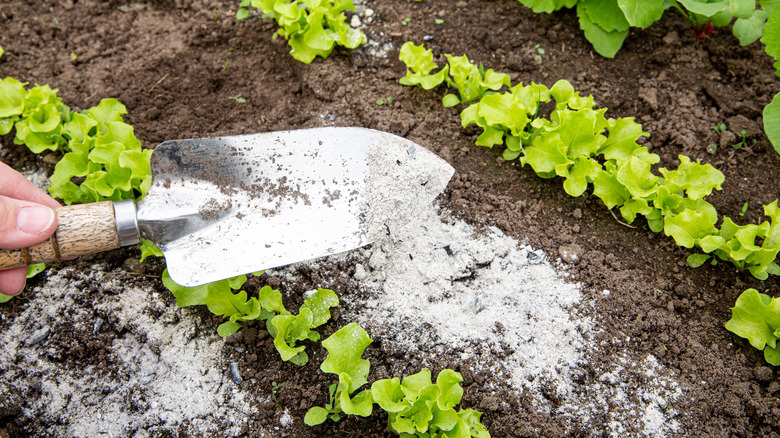Keep Hungry Grasshoppers Out Of Your Garden With Two Common Kitchen Ingredients
Identifying grasshopper damage involves observing telltale signs. Partially consumed leaves with irregular edges and jagged patterns are common indicators of their presence. Frequent sightings of grasshoppers are also an obvious sign of infestation. In more severe cases, entire plants may be stripped of foliage, hindering growth and reducing overall productivity. Nevertheless, you likely have two common kitchen staples that are a powerful deterrent for keeping grasshoppers at bay. Pop over to your pantry and break out your bag of all-purpose flour and a few heads of garlic to get started on managing your grasshopper problem.
Grasshoppers pose a notable threat to gardens, as their voracious appetites can lead to substantial plant damage. These insects feed on a wide array of garden crops and ornamental plants, consuming leaves, stems, and flowers. Their rapid reproductive rate and ability to cover large distances exacerbate their detrimental impact on the vitality of your garden. Understanding their behavior is important for effective garden protection. Grasshoppers rely on their hind legs for jumping and exhibit various color patterns to aid in camouflage. With a wide range of species, grasshoppers contribute to ecosystems as both prey for predators and pollinators for certain plants. In gardens, however, their unmonitored presence can result in significant harm, requiring careful monitoring and appropriate mitigation measures.
How to repel grasshoppers with flour
Using flour in a garden to deter grasshoppers is a natural, inexpensive, and non-toxic method that targets the insects' behavior. The flour, when dusted lightly onto plant leaves, creates an undesirable coating on the surface. Grasshoppers rely on consuming tender plant tissues, and the presence of flour disrupts their ability to feed efficiently by clogging their mouths, as it forms a gum or paste when combined with their saliva. On a dry day, head outside with a cup of flour and a paintbrush or makeup brush and dust your plants with a coating of flour to crack down on your grasshopper population.
Flour's use in gardens to ward off grasshoppers is generally considered safe for plants. It doesn't contain harmful chemicals and won't negatively impact the health of the vegetation. Since flour is a common food substance, it poses minimal risk to the environment, beneficial insects, and other animals that may visit the garden. However, it's important to apply it sparingly and evenly to avoid suffocating the plants or creating an excessive buildup of material. Regular reapplication might be necessary, especially after rainfall or heavy irrigation.
How to repel grasshoppers with garlic
Another natural method of repelling grasshoppers is to make a DIY garlic spray. To make your solution, mince or crush about four cloves of garlic and place them in a container with a tablespoon of mineral oil. Let this mixture steep for 24 hours. Strain the garlic-infused oil into a quart-sized spray bottle, discarding the garlic pieces. Mix in one teaspoon of liquid soap as an emulsifier. Fill a spray bottle with water and shake well to create a garlic spray concentrate.
To use the spray, dilute the concentrate by mixing 2 tablespoons of the garlic concentrate with a pint of water. Stir or shake well. Test the spray on a small portion of a plant to ensure it doesn't cause any negative effects. Once confirmed, apply the garlic spray to the plants, ensuring thorough coverage of both upper and lower leaf surfaces, as well as stems. Repeat the application once a week, especially after rainfall or heavy watering.
The effectiveness of garlic spray against grasshoppers is due to its strong odor and natural compounds. Garlic contains sulfur compounds, which act as repellents for many insects, including grasshoppers. When they come into contact with the garlic spray, they are deterred by the pungent smell, which disrupts their feeding and movement patterns. This natural approach to pest control is environmentally friendly and poses minimal risk to beneficial insects, plants, and the ecosystem as a whole.


